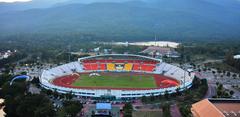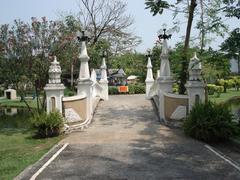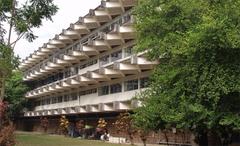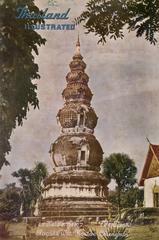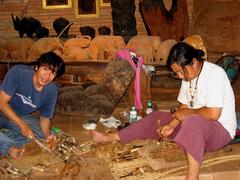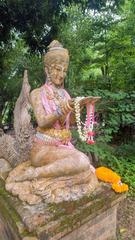Visiting Wat Chet Yot in Mueang Chiang Mai: Hours, Tickets, and Tips
Date: 18/07/2024
Introduction
Wat Chet Yot, officially known as Wat Photharam Maha Vihara, is an architecturally and historically significant Buddhist temple located in Mueang Chiang Mai, Thailand. Constructed in 1455 under the reign of King Tilokkarat of the Lanna Kingdom, the temple is renowned for its unique blend of Lanna, Indian, and Burmese architectural styles. The temple’s name, ‘Chet Yot,’ translates to ‘Seven Spires,’ symbolizing the seven weeks Buddha spent meditating under the Bodhi tree after attaining enlightenment. This historical and spiritual landmark offers visitors a rich tapestry of cultural heritage and religious significance (source).
Wat Chet Yot has played host to several pivotal historical events, including the Eighth World Buddhist Council in 1477, where the Pali Canon, the scriptures of Theravada Buddhism, was revised and standardized. This event underscored the temple’s importance in the dissemination and practice of Buddhism in Southeast Asia (source). With its intricate carvings, serene environment, and ongoing religious and cultural activities, Wat Chet Yot remains a vital part of Chiang Mai’s cultural landscape and a must-visit for both tourists and pilgrims (source).
Table of Contents
- and-construction)
- influences)
- events)
- significance)
- and-preservation)
- and-iconography)
- practices)
- engagement)
- information)
- attractions)
- Day Relevance](#day-relevancemodern-day-relevance)
Origins and Construction
Wat Chet Yot, also known as Wat Photharam Maha Vihara, is a historically significant Buddhist temple located in Mueang Chiang Mai, Thailand. The temple was constructed in 1455 during the reign of King Tilokkarat of the Lanna Kingdom. The temple’s name, “Chet Yot,” translates to “Seven Spires,” referring to the seven chedis (stupas) that adorn the temple’s main structure. These chedis are believed to symbolize the seven weeks that Buddha spent meditating under the Bodhi tree after attaining enlightenment.
Architectural Influences
The architecture of Wat Chet Yot is a unique blend of Lanna, Indian, and Burmese styles. The temple’s main structure, the Maha Bodhi Vihara, is modeled after the Mahabodhi Temple in Bodh Gaya, India, where Buddha attained enlightenment. This architectural choice underscores the temple’s spiritual significance and its connection to the broader Buddhist world. The seven spires of the temple are reminiscent of the Mahabodhi Temple’s design, making Wat Chet Yot a rare example of Indian influence in Thai temple architecture (source).
Historical Events
Wat Chet Yot has been the site of several important historical events. In 1477, the Eighth World Buddhist Council was convened at the temple. This council was significant for its role in revising and standardizing the Pali Canon, the scriptures of Theravada Buddhism. The council’s decisions had a lasting impact on the practice and dissemination of Buddhism in Southeast Asia (source).
Cultural Significance
Wat Chet Yot holds immense cultural significance for the people of Chiang Mai and the broader Lanna region. The temple is a center for various religious ceremonies and festivals, particularly during the Thai New Year (Songkran) and the Loy Krathong festival. During these times, the temple grounds are filled with devotees participating in traditional rituals, making merit, and paying homage to the Buddha.
Restoration and Preservation
Over the centuries, Wat Chet Yot has undergone several restoration efforts to preserve its historical and architectural integrity. Notably, in the early 20th century, the Fine Arts Department of Thailand undertook significant restoration work to repair damage caused by natural wear and tear. These efforts have ensured that the temple remains a vital part of Chiang Mai’s cultural heritage (source).
Art and Iconography
The temple complex is adorned with intricate carvings and statues that reflect the artistic traditions of the Lanna Kingdom. The exterior walls of the Maha Bodhi Vihara feature stucco reliefs depicting various scenes from the Jataka tales, which narrate the previous lives of the Buddha. These artistic elements not only enhance the temple’s aesthetic appeal but also serve as educational tools for devotees and visitors, illustrating key aspects of Buddhist teachings (source).
Religious Practices
Wat Chet Yot continues to be an active center of worship and religious practice. Monks residing at the temple engage in daily rituals, meditation, and teachings, contributing to the spiritual life of the local community. The temple also offers meditation retreats and Dhamma talks, attracting both Thai and international practitioners seeking spiritual growth and enlightenment.
Community Engagement
The temple plays a crucial role in the local community, serving as a hub for social and charitable activities. Wat Chet Yot organizes various community outreach programs, including educational initiatives, health services, and support for the underprivileged. These efforts reflect the temple’s commitment to the Buddhist principle of compassion and its role in fostering social harmony and well-being.
Visitor Information
Visiting Hours
Wat Chet Yot is open to visitors from 8:00 AM to 5:00 PM daily. It is recommended to visit early in the morning or late in the afternoon to avoid the heat and crowds.
Ticket Prices
There is no admission fee to enter Wat Chet Yot, but donations are appreciated to help with the temple’s maintenance and community activities.
Travel Tips
- Dress modestly: Shoulders and knees should be covered.
- Remove your shoes: Before entering any of the temple buildings.
- Be respectful: Of the religious practices and the monks.
- Photography: Is allowed, but avoid using flash inside the temple buildings.
Nearby Attractions
- Wat Phra Singh: Another significant temple in Chiang Mai known for its beautiful Lanna architecture.
- Chiang Mai Old City: Explore the historic center of Chiang Mai with its ancient temples, museums, and cultural sites.
- Nimmanhaemin Road: A trendy area with cafes, boutiques, and art galleries, perfect for a leisurely stroll after visiting Wat Chet Yot.
Modern-Day Relevance
In contemporary times, Wat Chet Yot remains a popular destination for both tourists and pilgrims. Its historical significance, architectural beauty, and serene environment make it a must-visit site for those exploring Chiang Mai. The temple’s ongoing religious and cultural activities ensure that it continues to be a living monument, bridging the past and present in meaningful ways (source).
FAQ
Q: What are the visiting hours for Wat Chet Yot? A: Wat Chet Yot is open daily from 8:00 AM to 5:00 PM.
Q: Is there an admission fee for Wat Chet Yot? A: No, there is no admission fee, but donations are appreciated.
Q: Can I take photos at Wat Chet Yot? A: Yes, photography is allowed, but please avoid using flash inside the temple buildings.
Q: What should I wear when visiting Wat Chet Yot? A: Visitors should dress modestly, covering their shoulders and knees.
Conclusion
Wat Chet Yot stands as a testament to the rich cultural and religious heritage of the Lanna Kingdom. Its unique architectural style, historical significance, and ongoing role in the community make it a vital part of Chiang Mai’s cultural landscape. Visitors to the temple can not only appreciate its historical and artistic value but also engage with the living traditions of Thai Buddhism, making their visit a deeply enriching experience.
References
- Lonely Planet. (n.d.). Wat Chet Yot. Retrieved from https://www.lonelyplanet.com/thailand/chiang-mai/attractions/wat-chet-yot/a/poi-sig/1142785/357551
- Bangkok.com. (n.d.). Wat Chet Yot. Retrieved from https://www.chiangmai.bangkok.com/attractions/wat-chet-yot.htm
- Tourism Thailand. (n.d.). Wat Chet Yot. Retrieved from https://www.tourismthailand.org/Attraction/wat-chet-yot
- TripAdvisor. (n.d.). Wat Chet Yot (Seven Spires). Retrieved from https://www.tripadvisor.com/Attraction_Review-g293917-d447142-Reviews-Wat_Chet_Yot_Seven_Spires-chiang_mai.html
